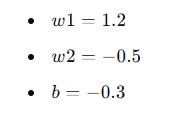Testing a Perceptron in Machine Learning
Once a perceptron has been trained, the next step is to test its performance on new, unseen data. Testing helps evaluate the accuracy and generalizability of the perceptron model.
Steps to Test a Perceptron
1: Prepare Test Data:
- Gather a separate dataset that was not used during the training phase. This dataset should have the same features as the training data and should include the actual labels for evaluation.
2: Forward Pass:
- For each instance in the test dataset, compute the weighted sum of inputs and apply the activation function to get the predicted output.
3: Compute Predictions:
- Compare the predicted outputs with the actual labels to determine how well the perceptron performs on the test data.
Detailed Testing Process
Here's a step-by-step process to test a perceptron:
1: Initialize Variables:
- Initialize a counter to keep track of correct predictions.
2: Loop Through Test Data:
- For each test example, perform the following steps:
1: Calculate Weighted Sum:

2: Apply Activation Function:
- Use the step function or another activation function to determine the predicted output.

3: Compare with Actual Output:
- Compare the predicted output (y^)with the actual output (y) of the test data.
3: Calculate Accuracy:
After iterating through all test examples, calculate the accuracy of the perceptron.

Example of Testing a Perceptron
Let's illustrate the testing process with an example:
Test Data
Assume we have the following test data with two features and binary labels:

Trained Perceptron Parameters
Assume the perceptron has been trained with the following weights and bias:
